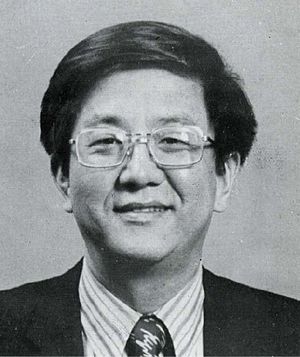Benjamin W. Lee facts for kids
Quick facts for kids
Benjamin Whisoh Lee
|
|
|---|---|
 |
|
| Born | January 1, 1935 |
| Died | June 16, 1977 (aged 42) Kewanee, Illinois, U.S.
|
| Nationality |
|
| Alma mater | |
| Known for |
|
| Spouse(s) | Marianne Mun Ching Sim |
| Awards |
|
| Scientific career | |
| Fields | |
| Institutions |
|
| Doctoral advisor | Abraham Klein |
| Notable students | Burt Ovrut |
| Influenced | |
| Korean name | |
| Hangul | |
| Hanja | |
| Revised Romanization | I Hwiso |
| McCune–Reischauer | I Hwiso |
| Signature | |
 |
|
| Notes | |
|
Biography of Benjamin W. Lee by JooSang Kang
|
|
Benjamin Whisoh Lee (Korean: 이휘소; January 1, 1935 – June 16, 1977), also known as Ben Lee, was an American theoretical physicist. He was born in Korea. A theoretical physicist uses math and models to understand how the universe works. His work greatly helped develop the Standard Model of particle physics. This model describes the basic forces and particles that make up everything.
He was especially important for his work on renormalization and gauge theory. These are complex ideas that help scientists understand how tiny particles interact. He also predicted the mass of the charm quark, a type of fundamental particle. During his career, he published many important scientific papers. His work is still cited by scientists today. He is also the inspiration for a character in a famous Korean novel.
Contents
About Benjamin Lee's Life
Lee was born in Yongsan, Seoul, in 1935. Both of his parents were doctors. His mother was the main earner for the family. She worked as a doctor and later opened her own clinic. Benjamin was the oldest of four children.
He was a very bright student. He got into Kyunggi Middle School and was excellent there. The Korean War started when he was in his fourth year of school. His family moved to Busan to stay safe. He continued his schooling there. Before finishing high school, he started at Seoul National University. He studied chemical engineering.
Later, he moved to the United States. He received a scholarship to study there. He earned his Bachelor's degree from Miami University in 1956. Then, he got his Master's from the University of Pittsburgh in 1958. He completed his Ph.D. at the University of Pennsylvania in 1961.
Lee worked at several important places. These included the Institute for Advanced Study and Fermilab. He was also a physics professor at the University of Pennsylvania, Stony Brook University, and the University of Chicago. He was chosen as a Fellow of the American Academy of Arts and Sciences in 1976. Sadly, he died in a car accident in 1977. He was considered a top physicist at the time of his death.
Benjamin Lee's Research
Understanding Gauge Theory
In 1964, Benjamin Lee worked with his advisor, Abraham Klein. They published an article about something called spontaneous symmetry breaking. This work helped lead to the idea of the Higgs mechanism. The Higgs mechanism explains how particles get their mass.
Lee is often given credit for naming the Higgs boson. This is a fundamental particle linked to the Higgs mechanism. In 1969, he successfully worked on the renormalization of a gauge symmetry model. Renormalization is a way to make sense of calculations in particle physics.
A Dutch student named Gerard 't Hooft was also working on similar ideas. He met Lee at a summer school. Lee gave him important advice. 't Hooft later won the Nobel Prize for his work on non-abelian gauge theory. Another physicist, Hugh David Politzer, said that scientists learned a lot from Lee. Lee combined his own ideas with those from Russian physicists. He also encouraged 't Hooft's important paper.
Predicting the Charm Quark
Scientists Glashow, Maiani, and Iliopoulos predicted the existence of charm quarks. They did this to explain some experimental results. Benjamin Lee wrote a paper with Gaillard and Rosner. In this paper, they calculated the mass of the charm quarks. They did this by looking at how K mesons (a type of particle) mix and decay. Their prediction helped in the search for this new particle.
Discoveries in Cosmology
In 1977, Lee and Weinberg wrote an important paper. It was about the minimum mass for heavy neutrinos. Neutrinos are tiny particles with very little mass.
They showed that if heavy, stable particles from the early universe still exist today, they must have interacted strongly enough. This calculation helps scientists figure out how much dark matter there is in the universe. Dark matter is a mysterious substance that we can't see. This idea is now known as the Lee-Weinberg bound.
Promoting Gauge Theories
In 1967, Steven Weinberg wrote a very important paper. It was called A Model of Leptons. This paper is still cited by scientists today. In 1972, Benjamin Lee gave a talk at a conference. The talk was called Perspectives on Theory of Weak Interactions. Lee's talk helped bring Weinberg's 1967 paper to wider attention. He explained many parts of gauge theories to a large group of scientists. This helped other physicists understand these complex ideas better.

